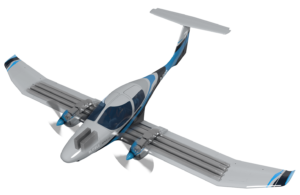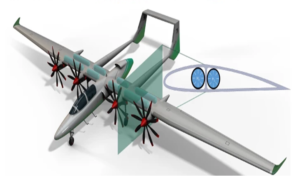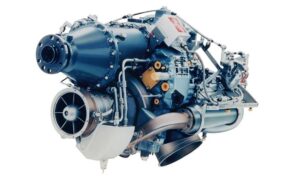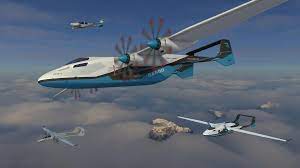Designs to Fly “Without Harm for the Climate”
APUS (Latin for swift bird) has announced two aircraft, the i-2 and i-5, that will offer either zero emission or very low emission flight. The designs represent some highly innovative thinking and excellent performance.
APUS states its mission as, “Flying without any Harm for Climate!” To that end, they are developing four craft that will fly on green hydrogen power. Partnered with, “PowerCell (Hydrogen Fuel Cells), Fraunhofer (High-Voltage applications), COTESA (hydrogen storage solutions) and HEGGEMANN (hydrogen supply and safety systems) we are developing certified powertrain units for emission-free air transportation applications.”
APUS i-2, Zero-Emission General Aviation Aircraft
In a recent discussion with CEO Dipl.-Ing.Phillip Scheffel; Laurent Altenberger ,an Aerospace Project and Supply Chain Management Consultant in Business Development; and Dipl.-Ing. Robert Adam, a company co-founder and head of powertrain development, your editor learned how committed APUS is in the matter of promoting environmentally friendly flight. APUS itself goes back to the 2011 Green Speed Cup, a combination speed and economy run for light aircraft, organized by Robert Adam.
In the last 12 years, APUS has grown to be a leading resource in aircraft design, construction, and certification. In fact, their i-2 emission-free, four-seat design is headed for certification in the normal category (CS-23).

APUS i-2 will be certified in the CS23 category
The 2,200-kilogram (4,840-pound) twin motor, hydrogen fueled aircraft will have a range of 500 nautical miles (575 statute miles) and cruise at 160 knots (184 mph). It’s meant to operate in a normal environment, although its 175(?) kilowatt fuel cells will enable it to be 100-percent “zero CO2, NOx, and zero noise,” as claimed by the firm.
Hydrogen-storing tubes, (TUBESTRUCT), are an “integral high-pressure tube tank. Four-tube structures distributed across the chord of wing on the i-2, the tubes are loaded under high internal pressure as well as able to absorb thrust and torsion loads from stresses in the flight. The tubes can absorb hydrogen, methane or other volatile gases.”

Tubestruct is a structural element as well as a container for on-board hydrogen fuel
This description from Mr. Scheffel’s 2017 patent application gives a sense of the multiple functions fulfilled by these tubes. In essence, pressurized H2 in the tubes will help stiffen them against the aerodynamic forces on the wings.
The carbon fiber tubes can benefit from fiber orientation that enables resisting stresses from multiple directions, as well as containing 350 to 700 bar (5,076 to 10,150 PSI) hydrogen. According to APUS, this permits, “Up to 25-percent higher energy density compared with standard hydrogen fuel tanks and ten times better energy density than battery-electric aircraft, all while avoiding the use of rare minerals that batteries employ.”
Shown at Hannover and at Aero Expo at Friedrichshafen, the TUESTRUCT tanks were developed in partnership with COTESA. The aircraft will be able to be refueled with “low-cost and non-cooled hydrogen already available” for cars and trucks. Such non-specialized operation should speed transition to these new methods.
Future Plans
APUS will finish building the i-2 and embark on a thorough flight test program while proceeding with even larger examples – some now under construction. Four-motor i-5 variants will include cargo, passenger, and a “Multi-Mission” ISR (Intelligence, surveillance, and reconnaissance) platform. Their large-span, high-aspect-ratio wings will enable longer range and high altitudes
APUS i-5 “Carrier”
Combining high-performance aerodynamics, cargo volume, hydrogen fueled electric motors boosted by high-power batteries, the 600 kilowatt (804 horsepower) craft will achieve high levels of efficiency and zero CO2 emissions. The power train includes:
“Two 100 kW hydrogen fuel cells for zero emission level flight.
“Four 150 kW electric motors with low rpm.
“Highly efficient 9-blade propellers for lowest noise emission.”
The Carrier will come as two variants: Variant A, a Cargo Carrier; and Variant B, a Passenger Carrier. Each variant has 19 meter (62.3 foot) high-aspect-ratio wings
Two other power variants are also possible. First is a combination of Sustainable Aviation Fuel engines on the inboard part of the wing and electric motors driven by hydrogen on the outboard. Second is a set of four fuel-cell-powered electric motors driving all four propellers. This hydrogen version should give great range with zero emissions.
High Cargo and Passenger Volume, Low Expenses
Those high aspect-ratio-sailplane-like wings enable high rates of climb for a large payload. Coupled with a high-volume interior, large payloads can be carried on lower fuel use. Hydrogen power also means zero CO2 emissions.
The large interior for both Cargo and Passenger Carrier variants (6 meters, or 19.7 feet long, 1.4 meters or 4.6 feet wide, and 1.5 meters or 4.9 feet high) enable bulky cargo similar to that carried by urban delivery trucks. In fact, the 12.6 cubic meters (445 cubic feet) of cargo or passenger space is roughly equivalent to a large American 16-passenger van. Seating arrangements in the passenger version approximate that capability.

APUS i-5 Cargo configuration enables easy loading and unloading
Even the design of the twin booms supporting a high tail enables parking a cargo van behind the rear door of the cargo compartment and transferring cargo quickly.
A payload of 1.770 kilograms (3,984 pounds) and fully-loaded weight of 5,000 kilograms (11,000 pounds) means the i-5 carries only 13.67 pounds per foot of span. Couple that with a power loading of 13.68 pounds per horsepower, and the i-5 should enjoy relatively short takeoffs and a respectable rate of climb. Its high-aspect-ratio wing will allow high cruising altitudes on low power.
That leads to economy of operation. The i-5’s long wings not only help reduce induced drag and extend range, but also lower costs per mile. Green hydrogen fuel should become more available and much less expensive over time, and is even now comparable to costs for fossil fuels. Future Flight.com reports, “Based on current hydrogen gas prices of around €5 per kilogram, the company is projecting seat-mile costs for the i-5 of just €0.13 and ton-mile costs for freight of €0.99.”
I-5 Multi-Mission ISR

Joining forces with Rolls-Royce, the multi-mission craft will have R-R’s hybrid-electric propulsion system built around an M250 turboshaft engine. Positioned in the rear of the fuselage, it will power the two outer electric motors on each wing: Sustainable Aviation Fuel (SAF) engines will power the inner Diesel engines. This configuration will allow an early market entry.

Rolls-Royce M250 turbine enables early market entry, provides hybrid power
A demonstrator for research purposes, the craft can carry a suite of long-range radar systems and sensors, including IO and IR (infrared) units.
Certification
APUS is already an EASA certified Design Organization offering high standards of aviation engineering services. To those capabilities, it added Part 21G certification on December 6, 2022 for Product Organization Approval, allowing the firm to manufacture, approve, and deliver aeronautical products. Their hangar certainly shows the diversity of product they already service.
– Composite molds
– Carbon reinforced epoxy parts
– Aviation metal welded structures
– Milled metal and plastic parts
– Electronic assemblies
A Challenge for the New Year
APUS head Dipl.-Ing. Phillip Scheffel greeted the New Year with a stirring resolution – and real hydrogen- powered aircraft under development. He shared this challenge for all of us.
“2023 for engineering a better world
“The point of no return is approaching. The boreal forests are dying, the permafrost is thawing and emitting gigantic amounts of methane, the polar ice is melting. Climate change is progressing at breakneck speed – visible to everyone and no news. But we have the opportunity to influence. We ALL have to take responsibility and promote a societal rethinking process. The problem will not be solved by politicians or other individuals, but mainly by the people – by us.
“APUS will make every effort to accelerate the technology transfer for aircraft engines also in 2023. In addition, APUS will also promote the expansion of renewable energies. Both areas are closely linked of course.
“But we need your support. Therefore my appeal today is aimed primarily at the gratifyingly large number of those who have already understood that the reduction of fossil resources must have top priority. Please discuss, explain, act and lead by example! Again and again and with all perseverance: (To your editor, these action items are wonderful, especially the idea of involving children.)
- “Talk to your family and friends
- “Involve children in the discussion, they understand it much more quickly and, with their innocent nature, can stimulate even adult stubborn people to think
- “Design your everyday life in a way that protects resources and show others how well this can work and how much fun it brings. The physical effect might be small, but the psychological effect is all the greater
- “Support ongoing measures and give active support.
- “Act efficiently (no greenwashing) and talk about it. I’m looking forward to the tasks of 2023 and I’m happy to be part of a generation that is playing a key role in shaping this change. Please join, there is no higher priority than that!” Rolf-Jürgen Moll, the founder of LucaNet AG, Berlin. recently formed a strategic partnership with the firm, strengthening their future.
With their engineering team, design and construction capabilities, and well-positioned plans for the future, we can only see a brilliant path ahead for APUS.

